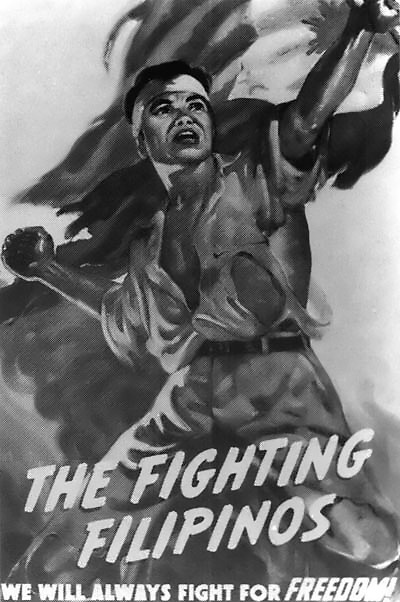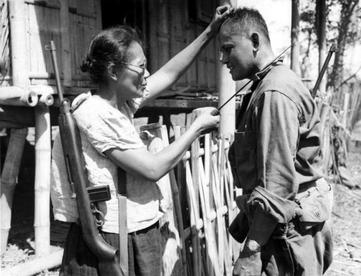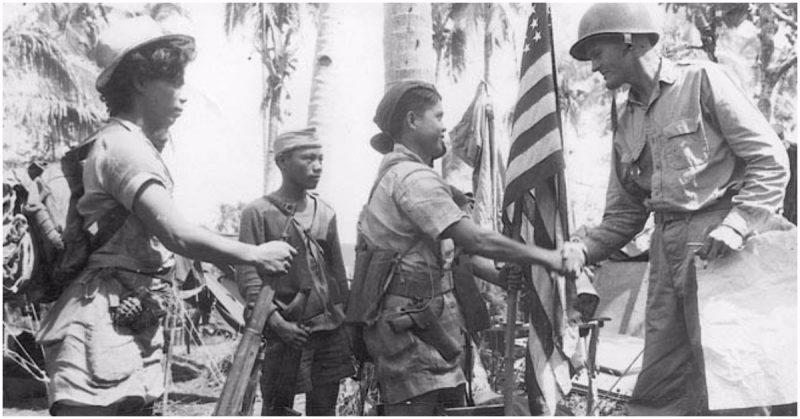Did the Japanese really conquer the Philippines? Well, they certainly beat the American and Philippine professional forces and toppled the government. But by the time General Douglas MacArthur landed American troops to retake the Philippines from the Japanese in October 1944, the Japanese Imperial forces only controlled 12 of the 48 provinces in the archipelago.
After the surrender of the Philippines to the Japanese in May, 1942, a vast array of guerrilla forces sprang up to fight the occupiers. U.S. and Filipino officers and soldiers, local leaders and citizens across the major islands, North to South, lead groups ranging from just a hundred or so to thousands of resistance fighters. MacArthur was in awe of their success and the tactics learned from the fierce native fighters of the Philippines have influenced the U.S. military to this day.
Some of the first guerrilla fighters to organize during the Japanese invasion were called the Hunters ROTC. Cadets of the Philippine Military Academy, lead by Cadet Terry Adivoso who were unable to join the U.S. Army Forces Far East (USAFFE) because they were too young, came together and began recruiting other cadets and willing fighters.
Originally numbering about 300, the Hunters operated in southern Luzon Island (the large northern island of the Philippines) and especially around Manila, the country’s capitol. In one early action, they raided the Japanese occupied Union College and absconded with over 100 old Enfield rifles.
By later 1942, the Allied Intelligence Bureau and the U.S. military were in contact with many of the Philippine’s guerrilla groups and helped them, by sending supplies and supplying intelligence.
Many of the groups they coordinated with were lead by USAFFE officers or soldiers who had risen up, after evading capture by the Japanese, to lead resistance from the Philippine’s various jungle, mountain, and urban regions. They would lead groups of men both American soldiers and native soldiers or citizens who wished to fight.
In one remarkable mission, U.S. Rangers and Alamo Scouts, along with Filipino guerrillas freed some 500 American and Allied POWs from a camp near Cabanatuan City on Luzon. Of the 133 American soldiers, only two were killed, and only about two dozen injuries were reported among the 250-280 Filipinos who participated. They killed hundreds of Japanese soldiers in the daring raid and rescued men, whom were soon to be executed, by the Japanese.

One guerrilla force the Americans worked with closely was the Wa Chi, a group of Chinese-Filipinos (immigrants and decedents) who fought to protect ethnic Chinese from Japanese cruelty. This group numbered about 700 men.
One skill these guerrilla groups had was in developing underground networks. They organized local intelligence gathering, secret radio transmitters, and had informants in the Second Philippine Republic (the Japanese-backed puppet government).
Another guerrilla group and one that worked with far less coordination with U.S. forces was the Hukbalahap. They were a communist group that hoped to spread their message and gain control of the Philippines after the Japanese had been defeated and indeed fought the Philippine government and U.S. forces for years after World War II ended. Their full title was Hukbong Bayan Laban sa mga Hapon or People’s Army Against the Japanese. They started operations with 500 men and grew to over 15,000 by the time the Japanese were defeated.
Various rebel groups in the Visayas, the central islands of the Philippines, worked with varying degrees of coordination with U.S. forces. One group, the Black Army, lead by Ruperto Kangleon played a crucial role in supporting U.S. operations, especially MacArthur’s invasion of Leyte island and the surrounding area.

One captain in the Black Army on Leyte was Captain Nieves Fernandez, the only female guerrilla commander in the Philippines. Once a schoolteacher, Fernandez now commanded 110 men. She specialized in improvised weaponry and even used a homemade shotgun. She was also a superb marksman and killed over 200 Japanese soldiers. The Japanese, in turn, put a 10,000 Peso price on her head.
In the Southern Philippines, mostly on the large island of Mindanao, the Moro population, the Muslim minority of the archipelago (the majority religion in Mindanao, though most of the rest of the Philippines in Catholic) who had been fighting an ongoing war with the Philippine government and the U.S. were also fighting hard against the Japanese. Their guerrilla groups were often very success, but also quite ruthless. One group, made up of some 20,000 Muslims and Christians, was called the Moro-Bolo. Their flag depicted a bolo, a traditional knife of the Philippines, and a kris, a fabled fashion of sword popular over the centuries with Muslims, in the Philippines and Indonesia.
Another Moro guerrilla group lead by Datu Busran Kalaw was approached by the Japanese who sought to play on their oriental ties to gain solidarity from them. In response, Kalaw constantly attacked the Japanese, who sent a large force to crush the stubborn Moros. None of those Japanese soldiers survived.
“Give me ten thousand Filipinos and I shall conquer the world!” said MacArthur (source: wikipedia.org), so taken was he by the resilience and strength of the native guerrilla forces against the Japanese. The U.S. officially recognized 277 guerrilla units and 260,715 individual fighters, mostly those associated with the Philippine Commonwealth. In reality, there were probably well over one million guerrillas resisting the Japanese. Many groups would fight for decades after the war to gain recognition from the U.S. and the veteran’s benefits that came with it.
American officers who led guerrilla forces in the Philippines used what they learned from Filipino fighters in the formation of the U.S. Special Forces, in the post-war period.
By Colin Fraser for War History Online
